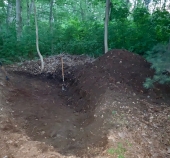
 3
3




Is there such a thing as too many projects going?
 3
3




 3
3




Zone 6, 45 inches precipitation, hard clay soil




 3
3




Check out Redhawk's soil series: https://permies.com/wiki/redhawk-soil
 4
4




Moderator, Treatment Free Beekeepers group on Facebook.
https://www.facebook.com/groups/treatmentfreebeekeepers/






 4
4




Some places need to be wild
 2
2





If you were so motivated, this is a great way to make use of mushrooms, especially Wine Cap mushrooms which can break down chips in one season, give you nice, fertile bedding and give you mushrooms.
If you are still interested, I can point you in the right direction.
Is there such a thing as too many projects going?




Zone 6, 45 inches precipitation, hard clay soil





 2
2




 1
1




Christopher Weeks wrote:I'm peeing on my wood chips to help them melt down more quickly.

|
Uh oh, we're definitely being carded. Here, show him this tiny ad:
Freaky Cheap Heat - 2 hour movie - HD streaming
https://permies.com/wiki/238453/Freaky-Cheap-Heat-hour-movie
|







